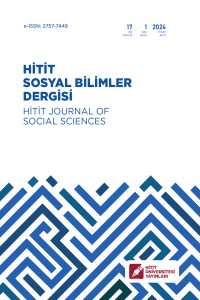Piyasa Sıcaklığının Hesaplanmasında Kullanılan Modeller: Kleinert ve Chen ile Subias Piyasa Sıcaklık Modellerinin Kıyaslanması ve Modifikasyon Önerisi
Models Used in the Calculation of Market Temperature: Comparison of Kleinert and Chen and Subias Market Temperature Models and Modification
Author(s): Hüseyin Serdar YALÇINKAYA, Nizamettin BAŞARANSubject(s): Supranational / Global Economy, Financial Markets, Accounting - Business Administration, Socio-Economic Research
Published by: Hitit Üniversitesi
Keywords: Econophysics; Market Temperature; Kleinert and Chen Market Temperature Model; Subias Market Temperature Model;
Summary/Abstract: Physics, which is accepted as a science, examines the cause, condition and change of the structures that have emerged depending on matter and matter. The structures that emerge in terms of physical science are examined in two basic cases as macro and micro structures, and inferences are obtained through the interaction of micro and macro states. Here, it is the examination of the interaction of molecular and atomic structures with the macro structure of matter as micro states. In economic sciences, each individual (agent) performing a transaction is considered as a micro state and its interaction with the macro state. Although it is thought that Fisher (1933) first proposed these simulationbased modelling, modelling analyses of physics and economic sciences by analogy with each other have been put forward in a much earlier period. The coming together of physics and economic sciences on a common denominator started with the interest of economists in the mathematical models that emerged due to the development of physics science and the curiosity of whether these models work with economic concepts. The convergence of physical and economic sciences in various aspects is not a new concept, but has a long history. In particular, the search for a causal relationship in the problems researched in all fields of science has led scientists to propose deterministic, mathematical, understandable and simple models. This situation has manifested itself in economic sciences as classical and neo-classical economic schools. However, stochastic analyses in the field of physics have affected economic sciences and especially the field of finance. The effort to explain economic problems with stochastic models, which started with the Keyness school of economics, led to the development of econometrics. The development of statistical physics in the field of physics has played a major role in the development of statistics and indirectly in the development of econometrics. In addition, it is understood from the research papers of the last 40-50 years that newly created probabilistic models are more successful than deterministic models in solving financial problems. The inference to be drawn from all these statements is that thermodynamics and thermodynamic theories, which are the main subject in the development of statistical physics, should be tested in economic sciences, especially in finance. The aim of this study is to investigate whether the concept of temperature in thermodynamics, which is one of the most fundamental issues in physics, can be calculated in financial time series. If a temperature concept can be established on financial time series and meaningful relationships can be established between the calculated temperature values and time series, a new analysis measure will emerge for financial analyses. The obtained temperature values can also be used in the solution of other financial problems with statistical physics concepts in future studies. In this framework, the first objective of our study is to investigate whether the concept of temperature can be calculated in financial time series, and also to compare the Kleinert and Chen Market Temperature Model and the Subias Market Temperature Model and to investigate which one is more successful in explaining the logarithmic returns of the S&P500 index. Another aim of the study is to modify and re-compare both models and contribute to the literature according to the findings obtained. In this framework, Kleinert and Chen Market Temperature Model and Subias Market Temperature Model were first used in the calculations, then both models were modified and market temperatures were recalculated and compared. In order to compare both market temperature models under the same conditions, daily closing data of the S&P 500 index between 02/01/2010 - 30/12/2022 were used. According to the results obtained from the findings, it is seen that both models do not produce sufficiently significant results, but after the modification of the models, market temperature data with negative temperature values are sufficient to explain the log returns of the S&P500 index. In addition, when the two models are compared, it is seen that the KCMT^ model is more successful in explaining the log returns of the S&P500 index than the SMT^ model.
Journal: Hitit Sosyal Bilimler Dergisi
- Issue Year: 17/2024
- Issue No: Sp. Issue
- Page Range: 144-158
- Page Count: 15
- Language: Turkish

